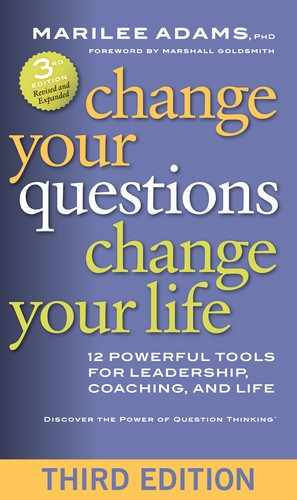Tool 9: Create Breakthroughs with Q-Storming®
Purpose: To empower collaborative, creative, and strategic thinking that can lead to breakthroughs and more successful results.
Discussion: In the story, Ben learns how to do Q-Storming from Charles, and it contributes to a breakthrough for Ben and their team.
Q-Storming is most often used when breakthroughs are sought in decision making, problem solving, strategic planning, and innovation. It provides a Learner structure for collaborative and creative thinking. It is a tool for moving beyond limited thinking and advancing to novel and extraordinary solutions and answers. While Q-Storming is akin to brainstorming, the goal of this Question Thinking practice is to generate as many questions as possible. The expectation is that some of the generated questions will provide desired new openings in thinking. Typically, questions open thinking, whereas answers often close thinking down.
Q-Storming is based on three premises: (1) Great results begin with great questions; (2) most any problem can be solved with enough right questions; and (3) the questions we ask ourselves often provide the most fruitful openings for new thinking and possibilities.
Q-Storming is typically done with a group or team, especially when one is exploring ideas and possibilities. It is also used in goal-oriented conversations between two people, for example, in coaching, leadership, management, and sales. Q-Storming can be done in person or virtually, say, with a global team or a coaching client in a different geographic location.
The facilitator and the team focus on developing a clear goal and eliciting assumptions about it before the question-generation phase of Q-Storming. Often at the end, action plans are made or revised based on discoveries made during the Q-Storming session.
QUESTION GUIDELINES
• Questions should be first-person singular or plural, using “I” and “we.” You want new questions to think with, not necessarily to ask of someone else.
• Generate questions from Learner mindset and avoid Judger.
• Questions are mostly open-ended, not closed (“How can I?” rather than “Can I?”) and (“How can we?” rather than “Can you?”)
• Invite courageous and provocative questions, as well as “silly” and “dumb” ones.
Note: Q-Storming is a powerful tool for creative thinking and for bringing together groups or organizations facing complex or challenges issues. Find out more about Q-Storming training and consulting at: www.InquiryInstitute.com.
